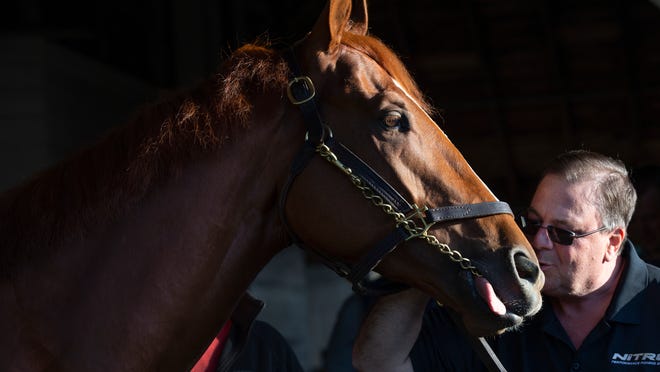

The decision to withhold Kentucky Derby winner Rich Strike from the Preakness Stakes has revived a long-running but recently dormant debate: whether the Triple Crown suffers from too tight a schedule.
As recently as 2014, former Maryland Jockey Club President Tom Chuckas proposed running the Preakness on the first Saturday in June rather than two weeks after the Derby as a concession to modern training methods and out of concern his signature race was being skipped by most of the top 3-year-olds.
Then came American Pharoah, and there went any momentum toward changing the Triple Crown calendar.
In ending a 37-year drought between Triple Crown winners, American Pharoah’s 2015 campaign contradicted claims that sweeping the 3-year-old classics had grown too difficult; that thoroughbred breeding had emphasized speed at the expense of stamina, resulting in less resilient racehorses.
When Justify completed another Triple Crown just three years later, the idea of revisiting racing’s calendar was widely seen as an overreaction to cyclical trends and solidified support for the traditional five weeks between the Derby and the Belmont Stakes as a demanding and defining test of greatness.
Then came the 80-1 longshot Rich Strike, winning the Derby this month before passing up a trip to Pimlico, and all bets were again off.
“Something like this was inevitable,” NBC analyst Randy Moss told the Baltimore Sun. “The spacing of the Triple Crown races should have been changed 15 years ago. It’s a complete anachronism for 2022.”
Kentucky Derby winner Rich Strike:Kentucky Derby winner Rich Strike to skip Preakness, look toward Belmont
Citation won 16 of his 17 races while winning the Triple Crown in 1948, with as few as four days between starts and a stop at the Jersey Stakes between the Preakness and the Belmont. Perhaps thoroughbreds were made of sterner stuff back then, but their workload has steadily decreased. According to The Jockey Club, the average starter raced 10.23 times as recently as 1975, but only 5.95 times last year.
Art Sherman, who trained California Chrome to Derby and Preakness wins in 2014, says it takes a horse about 11 days to fully recover from a race. His stated preference is that the Triple Crown be conducted over nine weeks instead of five and says the additional spacing would bring more Derby horses to Baltimore for the Preakness.
Last year, only three of the 19 Derby horses raced in the Preakness, with four empty spots in a starting gate limited to 14. Five Derby horses returned for the Belmont, but no horse ran in all three races.
“I’ve only been writing this for 20 years, but the spacing of the Triple Crown races needs to change to get the strongest, most competitive fields for all three races and to be fair to the horses,” the Paulick Report’s Ray Paulick posted on Twitter. “One month between races from first Saturday in May until first Saturday in July.”
Among those standing up for the status quo was trainer Graham Motion, who won the 2011 Kentucky Derby with Animal Kingdom.
“I see chatter on the Twitter of changing the Triple Crown, which I think would be a shame,” Motion wrote on Twitter. “It’s meant to be a challenge, it’s not meant to be easy.”
Related racing coverag:Kentucky Derby winner Rich Strike skipping Preakness sparks mixed reactions
Bill Finley echoed Motion’s argument in a column for the Thoroughbred Daily News.
“The reason why the Triple Crown should never be changed is simple and, I would think, obvious,” he wrote. “One of the reasons it is so hard to win is because the spacing of the races does indeed present a huge challenge. But that’s exactly the way it should be.
"This is very hard and that’s why it has only been done 13 times and every horse who has pulled it off is, rightly, considered an immortal. Putting more time between races would cheapen the accomplishment and all future Triple Crown winners would deserve to have an asterisk next to their names. That just can’t be.”
It’s at least arguable that adding time between races could make the Triple Crown more difficult because it would likely lead to stronger fields for the Preakness and the Belmont.
Todd Pletcher, who has won more money and saddled more Derby horses than any other trainer, generally avoids testing the same horse two weeks later unless a Triple Crown is still attainable. Bob Baffert never raced American Pharoah or Justify with only two weeks’ rest except for the Preakness.
Tradition, too, is not intractable. The Preakness has preceded the Derby 11 times in its history and has twice been run on the same day. The Belmont’s distance fluctuated until it was fixed at 1 ½ miles in 1926, and the race was run clockwise 52 times before it was first run counter-clockwise.
Things change. Basketball adopted a 3-point shot, baseball a designated hitter. Augusta National Golf Club has continually tweaked its layout in response to technological advancements and competitive considerations, most recently adding 35 yards prior to this year’s Masters.
“We have an obligation to the public to put our best racing on the table when the world is watching,” Tom Chuckas said, “and we are not doing that.”
Chuckas said that in 2014. Now comes Rich Strike to reopen the debate.
Tim Sullivan: 502-582-4650, [email protected]; Twitter: @TimSullivan714
Source link






